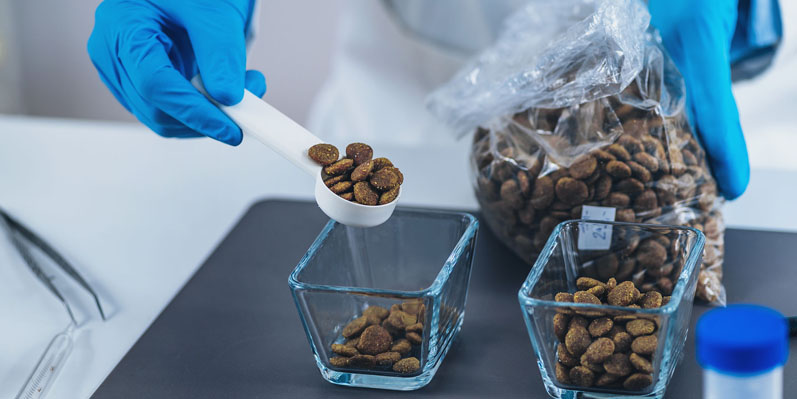Owing to the ongoing anthropomorphism of pets, owners are taking a closer look at what they’re feeding their beloved companions. Just as they themselves are opting for healthier and cleaner-label nutrition — and starting to consider the associated environmental aspects — owners want to ensure that the same standards apply to their pet’s meals.
This is manifesting as a shift towards providing fresh food or preferentially selecting more natural or organic pet food products.
Overall, the pet food sector is witnessing continuous growth. The market size in Europe is estimated to be worth $55 billion in 2024 and is expected to reach a value of more than $78 billion by 2029 (growing at a CAGR of approximately 7%).1
Next to classic feed compounds such as grain or meat, novel functional ingredients are gaining traction in this developing market. Many of these components can be both integrated into feed grades as well as pet-friendly nutraceuticals.
One example is carotenoids, which are not only known for their vibrant yellow, orange, or red colours, but also for their antioxidant attributes. One carotenoid with a particularly high antioxidant power — 110 times more than vitamin E — is astaxanthin.
In nature, the most abundant source of astaxanthin is a tiny microalga called Haematococcus pluvialis. Although astaxanthin has a long history as an ingredient in human supplements, its beneficial effects were first discovered in the marine world regarding the survival and reproduction rates of salmon.
Research on astaxanthin in aquaculture was also the basis for the Swedish company, AstaReal’s business. The organisation was the first to produce natural astaxanthin on an industrial level and, as the subject of more than 70 clinical studies on humans and animals, it owns today’s most researched astaxanthin brand in the market.
Species-specific research
“We wanted to understand what this might mean for different kinds of animals, so we started using the ingredient in trials with cats and dogs,” says Peter Ahlm, Head of Marketing & Sales at AstaReal.

Distinct research on targeted animals is indispensable when it comes to developing a safe and efficacious product; effects might vary between species and it’s imperative to optimise the ingredients’ amount to be dispensed.
There is a growing body of evidence to support the various positive effects of natural astaxanthin on pets’ health, many of which show a similar pattern to humans.
For instance, astaxanthin can support canine mobility, endurance and muscle recovery, the cardiovascular system, cognitive function, attentiveness and, at the cellular level, the mitochondria.2–5
Moreover, natural astaxanthin supplementation in dogs and cats could enhance their innate defence systems and improve both their cell-mediated and humoral immune responses.6,7 Astaxanthin also has shown potential to improve impaired vision owing to age-related conditions such as cloudy lenses in dogs.8
“The recorded health effects may seem quite diverse; however, they are all rooted in astaxanthin’s unique molecular structure."
"Owing to its linear, polar-nonpolar-polar molecular configuration, natural astaxanthin can effectively penetrate and traverse the cell and mitochondria membranes and neutralise reactive oxygen species (ROS) in both the hydrophobic interior and hydrophilic exterior boundaries."
"In addition to providing better protection to the cells and their powerhouses against oxidative stress, natural astaxanthin also has anti-inflammatory effects that support multiple bodily organs and systems,” says Behnaz Shakersain, Scientific Affairs Manager at AstaReal.
Scoring with natural astaxanthin options
As neither humans nor animals can produce astaxanthin in their bodies, they can only benefit from its protective functions through nutritional intake.
To obtain effective amounts, dogs are generally recommended to be fed 1 mg of astaxanthin per 10 kg body weight, which equates to about two wild king salmon fillets for a beagle or three for a golden retriever per day. Feed or treats rich in astaxanthin might offer an easier and more sustainable solution in many cases.
Natural algae-derived versions of astaxanthin offer additional advantages, such as higher levels of antioxidant potency. Moreover, algae play an essential role in the planet’s ecosystem and being recognised as a renewable resource resonates strongly with responsible consumers.
If algae are cultivated indoors, they can be better protected from environmental harm or contamination; plus, the yield of astaxanthin-rich algal biomass has a higher quality profile.
Developing a formula with healthy ingredients is only the first step, according to Peter Ahlm: “Pet food manufacturers also need to make sure that their product will remain stable and nutritious throughout its intended shelf-life."
"Bioactive substances are particularly prone to interact with other compounds in multi-ingredient formulations or can degrade during harsh production processes such as extrusion or pelleting.”

To minimise such risks and protect the power of astaxanthin, AstaReal uses encapsulation in its animal nutrition brand NOVASTA. Its recently launched NOVASTA EB15 can be mixed into pet food or added to supplements and consists of algal flour (32%) encapsulated in rapeseed oil with a final astaxanthin concentration of 1.5%.
Because of the encapsulation, it can be better incorporated into challenging formulations such as pellets, meal mixes and soft chews, which are more likely to be exposed to air at ambient temperature.
If manufacturers are sensitive to the shifting demands of pet parents and are willing to combine health with sustainability trends, they are well set. Algal astaxanthin can play a positive role in these efforts.
Thanks to its antioxidant and multifunctional effects, it naturally supports the well-being of our four-legged friends while stemming from a futureproof source.
References
- www.mordorintelligence.com/industry-reports/pet-food-market-in-europe-industry.
- B.M. Zanghi, et al., “Effects of Postexercise Feeding of a Supplemental Carbohydrate and Protein Bar with or without Astaxanthin from Haematococcus pluvialis to Exercise-Conditioned Dogs,” Am. J. Vet. Res. 76(4), 338–350 (2015).
- T. Murai, et al., “Effects of Astaxanthin Supplementation in Healthy and Obese Dogs,” Veterinary Medicine: Research and Reports 10, 29–35 (2019).
- National Center for Biotechnology Information, “PubChem Patent Summary for US-9820497-B2, Astaxanthin-Containing Pet Foods.” https://pubchem.ncbi.nlm.nih.gov/patent/US-9820497-B2.
- J.S. Park, et al., “Astaxanthin Modulates Age-Associated Mitochondrial Dysfunction in Healthy Dogs,” Journal of Animal Science 91(1), 268–275 (2013).
- B.P. Chew, et al., “Dietary Astaxanthin Enhances Immune Response in Dogs,” Veterinary Immunology and Immunopathology 140(3–4), 199–206 (2011).
- J.S. Park, et al., “Astaxanthin Stimulates Cell-Mediated and Humoral Immune Responses in Cats,” Veterinary Immunology and Immunopathology 144, 455–461 (2011).
- W. Wang, et al., “Antioxidant Supplementation Increases Retinal Responses and Decreases Refractive Error Changes in Dogs,” Journal of Nutritional Science 5, E18 (2016).
